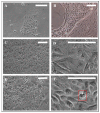Improved In Vitro Model for Intranasal Mucosal Drug Delivery: Primary Olfactory and Respiratory Epithelial Cells Compared with the Permanent Nasal Cell Line RPMI 2650
- PMID: 31374872
- PMCID: PMC6723747
- DOI: 10.3390/pharmaceutics11080367
Improved In Vitro Model for Intranasal Mucosal Drug Delivery: Primary Olfactory and Respiratory Epithelial Cells Compared with the Permanent Nasal Cell Line RPMI 2650
Abstract
Background: The epithelial layer of the nasal mucosa is the first barrier for drug permeation during intranasal drug delivery. With increasing interest for intranasal pathways, adequate in vitro models are required. Here, porcine olfactory (OEPC) and respiratory (REPC) primary cells were characterised against the nasal tumour cell line RPMI 2650.
Methods: Culture conditions for primary cells from porcine nasal mucosa were optimized and the cells characterised via light microscope, RT-PCR and immunofluorescence. Epithelial barrier function was analysed via transepithelial electrical resistance (TEER), and FITC-dextran was used as model substance for transepithelial permeation. Beating cilia necessary for mucociliary clearance were studied by immunoreactivity against acetylated tubulin.
Results: OEPC and REPC barrier models differ in TEER, transepithelial permeation and MUC5AC levels. In contrast, RPMI 2650 displayed lower levels of MUC5AC, cilia markers and TEER, and higher FITC-dextran flux rates.
Conclusion: To screen pharmaceutical formulations for intranasal delivery in vitro, translational mucosal models are needed. Here, a novel and comprehensive characterisation of OEPC and REPC against RPMI 2650 is presented. The established primary models display an appropriate model for nasal mucosa with secreted MUC5AC, beating cilia and a functional epithelial barrier, which is suitable for long-term evaluation of sustained release dosage forms.
Keywords: RPMI 2650; barrier model; nose-to-brain; olfactory epithelium; primary cells; respiratory epithelium.
Conflict of interest statement
The authors declare no conflicts of interest.
Figures





Similar articles
-
Application of RPMI 2650 as a cell model to evaluate solid formulations for intranasal delivery of drugs.Int J Pharm. 2016 Dec 30;515(1-2):1-10. doi: 10.1016/j.ijpharm.2016.09.086. Epub 2016 Oct 1. Int J Pharm. 2016. PMID: 27702697
-
Impact of Glycosylation and Species Origin on the Uptake and Permeation of IgGs through the Nasal Airway Mucosa.Pharmaceutics. 2020 Oct 23;12(11):1014. doi: 10.3390/pharmaceutics12111014. Pharmaceutics. 2020. PMID: 33114132 Free PMC article.
-
The Path from Nasal Tissue to Nasal Mucosa on Chip: Part 1-Establishing a Nasal In Vitro Model for Drug Delivery Testing Based on a Novel Cell Line.Pharmaceutics. 2023 Aug 30;15(9):2245. doi: 10.3390/pharmaceutics15092245. Pharmaceutics. 2023. PMID: 37765214 Free PMC article.
-
Tailoring Formulations for Intranasal Nose-to-Brain Delivery: A Review on Architecture, Physico-Chemical Characteristics and Mucociliary Clearance of the Nasal Olfactory Mucosa.Pharmaceutics. 2018 Aug 3;10(3):116. doi: 10.3390/pharmaceutics10030116. Pharmaceutics. 2018. PMID: 30081536 Free PMC article. Review.
-
The Upper Nasal Space: Option for Systemic Drug Delivery, Mucosal Vaccines and "Nose-to-Brain".Pharmaceutics. 2023 Jun 13;15(6):1720. doi: 10.3390/pharmaceutics15061720. Pharmaceutics. 2023. PMID: 37376168 Free PMC article. Review.
Cited by
-
A Dry Powder Platform for Nose-to-Brain Delivery of Dexamethasone: Formulation Development and Nasal Deposition Studies.Pharmaceutics. 2021 May 26;13(6):795. doi: 10.3390/pharmaceutics13060795. Pharmaceutics. 2021. PMID: 34073500 Free PMC article.
-
Research progress in brain-targeted nasal drug delivery.Front Aging Neurosci. 2024 Jan 17;15:1341295. doi: 10.3389/fnagi.2023.1341295. eCollection 2023. Front Aging Neurosci. 2024. PMID: 38298925 Free PMC article. Review.
-
Nasal Delivery of Acute Medications for Migraine: The Upper Versus Lower Nasal Space.J Clin Med. 2021 Jun 2;10(11):2468. doi: 10.3390/jcm10112468. J Clin Med. 2021. PMID: 34199479 Free PMC article. Review.
-
Pre-referral intranasal artesunate powder for cerebral malaria: a proof-of-concept study.Malar J. 2022 Oct 11;21(1):291. doi: 10.1186/s12936-022-04309-0. Malar J. 2022. PMID: 36221071 Free PMC article.
-
Intranasal Nose-to-Brain Drug Delivery via the Olfactory Region in Mice: Two In-Depth Protocols for Region-Specific Intranasal Application of Antibodies and for Expression Analysis of Fc Receptors via In Situ Hybridization in the Nasal Mucosa.Methods Mol Biol. 2024;2754:387-410. doi: 10.1007/978-1-0716-3629-9_21. Methods Mol Biol. 2024. PMID: 38512678
References
Grants and funding
LinkOut - more resources
Full Text Sources

